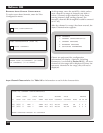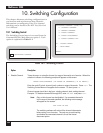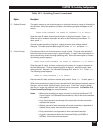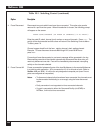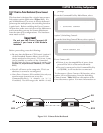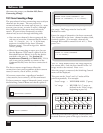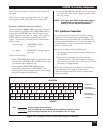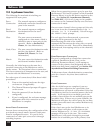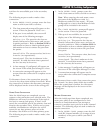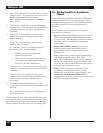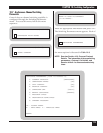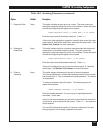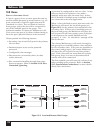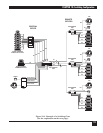
Multiserver 5000
112
10.5 Asynchronous Connections
The following five methods of switching are
supported for async ports:
Force The network operator configures a
Connection dedicated connection between two
ports in the network.
Fixed The network operator configures
Destination the destination for the user’s
channel.
Class The user enters a mnemonic,
configured as a class name, which is
defined as one or more ports in the
network. (Refer to Section 10.8,
Classes, for class information.)
Node/Class The user enters the destination node
and the class desired. (Refer to
Section 10.8, Classes, for class
information.)
Matrix The user enters the destination node
and channel number desired.
Generally, the initial steps are the same for a
terminal connecting to the Multiserver and its
feeder muxes. The exception is force-connection.
The force-connection is transparent to the user, and
no action with the Multiserver is necessary.
For other types of connections, follow these initial
procedures:
1. Turn on the terminal and enter the sign-
on character (if applicable).
2. The Channel Password prompt will appear
on the screen.
3. Enter the password (if one has been
configured).
4. If one is configured, the welcome message
will appear when the connection to the
Multiserver is complete.
A
SYNC FORCE-CONNECTIONS
In async force-connections, the configuration of the
port need not exactly match; however, both ports
must be configured as async. If a port is force-
connected, no other port can access it through
switching requests.
When force-connecting an async port, be sure that
the Remote CTS Control (option 2 of the Extended
Features Menu) is set for the device attached to the
port. (See Section 9.3, Asynchronous Channels,
and Table 9-12.) If it is not, it may not be possible
to connect to the Command Facility once the force-
connection is made.
Once an async channel is force-connected, the only
way it can access the Command Facility is via ^X
<break> (or ^X ^Y, if enabled). You will not get
the ENTER CLASS prompt.
For each port force-disconnected, a port-event
message will be generated in the log.
Disconnecting one side of the channel
automatically disconnects the other side; you need
only disconnect one side. Ports will be immediately
disconnected, interrupting activity on the channels
selected.
F
IXED DESTINATION CONNECTION
If a port is configured as a fixed-class connection
(option 8, Destination Node/Class, on the
Switching Parameters Menu), it will attempt to
connect to the primary class designated after the
initial steps have been completed (see Section 10.6
Asynchronous Channel Switching Parameters).
To disconnect from a fixed-destination connection,
press the <break> key three times within six
seconds.
C
LASS CONNECTION
After the initial steps are completed, you can
request a class connection for a particular class.
The Multiserver will search to determine if the class
is resident on itself or its attached muxes (the local
node). It will search for an available port in the
primary class and then for an available port on the
secondary class. If there are no ports available, the
Multiserver will place the call in queue for any busy
primary ports and search any remote Multiserver(s)
for the class.
If the class is not on the local Multiserver or its
feeders, then it will place a call request to the
remote Multiserver(s). A CALL IN PROGRESS
message will be sent to the user. The remote
Multiserver(s) will search through its ports and
feeders for an available port in the primary class



